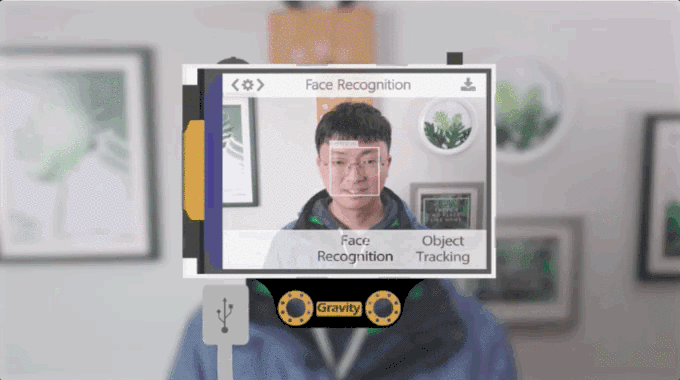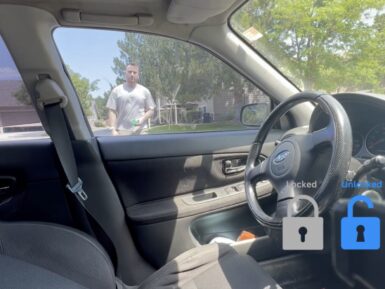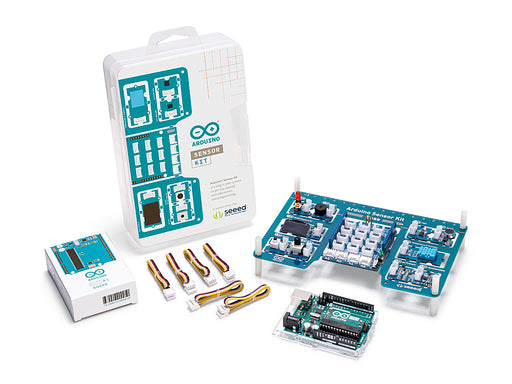
Gravity: HUSKYLENS - AI Machine Vision Sensor
Face recognition, AI, object tracking, machine vision and much more: this sensor brings these technologies to your project
Overview
HuskyLens is an easy-to-use AI machine vision sensor. It is equipped with multiple functions, such as face recognition, object tracking, object recognition, line tracking, color recognition, and tag(QR code) recognition.

Through the UART / I2C port, HuskyLens can connect yout Arduino board like to help you make very creative projects without playing with complex algorithms.

HuskyLens is pretty easy-to-use. You can change various algorithms by pressing the function button. Click the learning button, HuskyLens starts learning new things. After that, HuskyLens is able to recognize them.
Additionally, HuskyLens carries a 2.0 inch IPS screen. So you don’t need to use a PC in the parameters tuning. Enjoy the convenience it brings, what you see is what you get!

HuskyLens is designed to be smart. It has the built-in machine learning technology that enables HuskyLens to recognize faces and objects. Moreover, by long pressing the learning button, HuskyLens can continually learn new things even from different angles and in various ranges. The more it learns, the more accurate it is.

HuskyLens adopts the new generation of specialized AI chip Kendryte K210. The performance of this special AI chip is 1,000 times faster than that of the STM32H743 when running neural network algorithm. With these excellent performances, it is capable of capturing even fast-moving objects.
With the HuskyLens, yur projects have new ways to interact with you or environment, such as interactive gesture control, autonomous robot, smart access control and interactive toy. There are so many new applications for you to explore.

HuskyLens' object-tracking skills can be used to learn specific gestures. It is able to recognize those learned hand movement patterns and feed their positions. With these data, creating awesome interactive projects are never so easy.

HuskyLens can detect and follow lines. Line follower is not something new, there are plenty of excellent methods and algorithms in this scenario. However, most of them require tedious parameters tuning. This time, HuskyLens provides a new way to do line following: simply click the button, then it starts learning and tracking new lines. Let's enjoy the fun of making with HuskyLens!

HuskyLens can be eyes of robots. which allows your robot to recognize you, understand your hand gesture commands, or help you put stuff in order and so on. With Huskylens, nothing is impossible!
HuskyLens AI Vision Sensor Useful Functions
AI Projects made simple by Husky Lens | Giveaway
DOCUMENTS
SHIPPING LIST
- HuskyLens Mainboard x1
- M3 Screws x6
- M3 Nuts x6
- Small Mounting Bracket x1
- Heightening Bracket x1
- Gravity 4-Pin Sensor Cable x1
Tech specs
- Processor: Kendryte K210
- Image Sensor: OV2640 (2.0Megapixel Camera)
- Supply Voltage: 3.3~5.0V
- Current Consumption (TYP): 320mA@3.3V, 230mA@5.0V (face recognition mode; 80% backlight brightness; fill light off)
- Connection Interface: UART, I2C
- Display: 2.0-inch IPS screen with 320*240 resolution
- Built-in Algorithms: Face Recognition, Object Tracking, Object Recognition, Line Tracking, Color Recognition, Tag Recognition
- Dimension: 52mm * 44.5mm / 2.05 x 1.75inch
Get Inspired
Robot using Arduino Nano 33 BLE Camera Shield.

A lot of newer cars have a really nifty feature called “proximity unlock,” which automatically unlocks the doors when the driver approaches while carrying their key fob. When paired with a push-to-start ignition switch, the driver never has to take their keys out of their pocket. But Nick’s 2004 Subaru STI is too old to have come with that feature from the factory, so he used a couple of Arduino boards to create a DIY proximity unlock system. Car manufacturers need to pay serious attention to security when designing their access and ignition systems, but Nick had a bit more freedom. It is unlikely that any thieves would suspect his car of possessing a feature like this and so they wouldn’t even bother trying to hack it. Nick’s proximity unlock works by evaluating the received signal strength indicator (RSSI) of Bluetooth® Low Energy connection. If all else is equal, RSSI is inversely proportional to distance and that makes it useful for rough proximity detection. An Arduino Nano 33 BLE inside the car unlocks the doors when it has an active BLE connection with an RSSI over a set threshold. It unlocks the doors by shorting the switch with a 12V relay and it receives power from the car’s 12V system through a buck converter. The driver-carried device (equivalent to a key fob) can be either another Nano 33 BLE or Nick’s smartphone. In fact, it can be any device with a BLE adapter, so long as it can connect to the in-car Arduino with the proper device name. Now, Nick can enjoy his classic car and the convenience of proximity unlock.







